Smashed at the Weekend #14
Stein's summer seafood, Roti King recipes, a cocktail from Fonda and Notes on a Napkin
Somewhere to go: Rick Stein Pop Up at Fortnum’s at The Royal Exchange, London
If I had to name a desert island dish, it would be Rick Stein’s turbot hollandaise. There’s almost nothing to it - a tronçon (a slice across the fish rather than a fillet) cut from a big old fish, bone in and skin on, pan-roasted then finished in the oven. It’s served with a fish stock-based herb butter sauce and a classic hollandaise. It’s the epitome of both simplicity and luxury. There’s no elaboration, no spoonful of extraneous caviar, no microherbs, no edible flowers. Just the best thing you can pull out of the ocean and the finest sauce the French have invented, so far. It’s an example of the sort of confident cooking that many chefs strive for and fall short of.
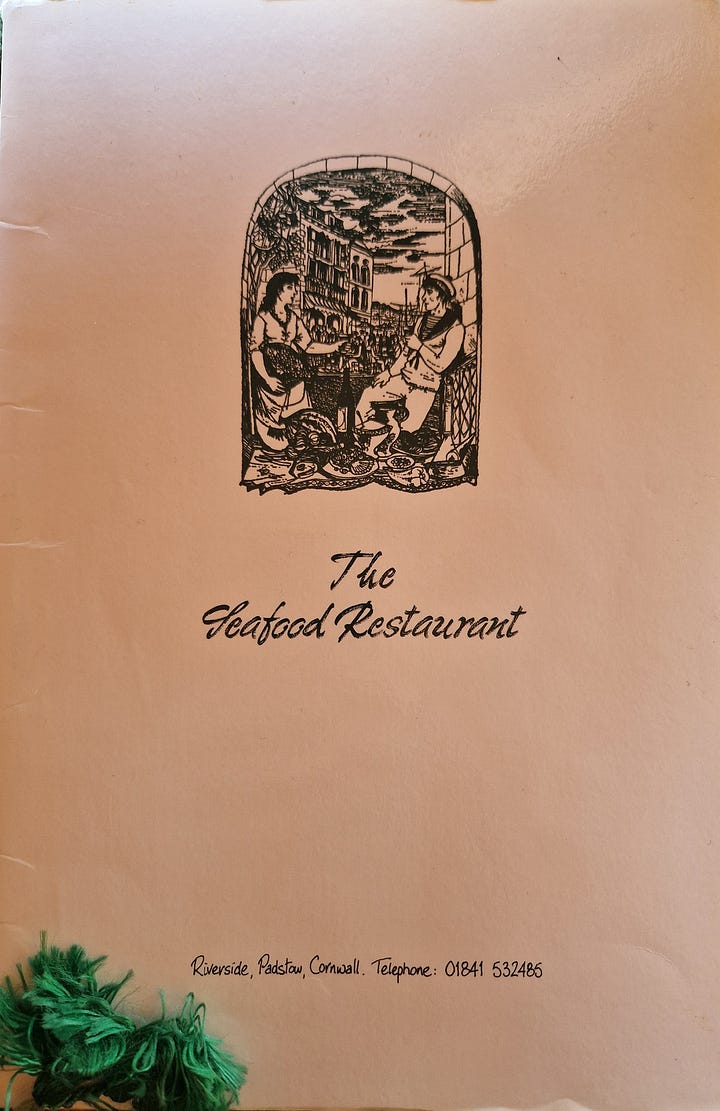
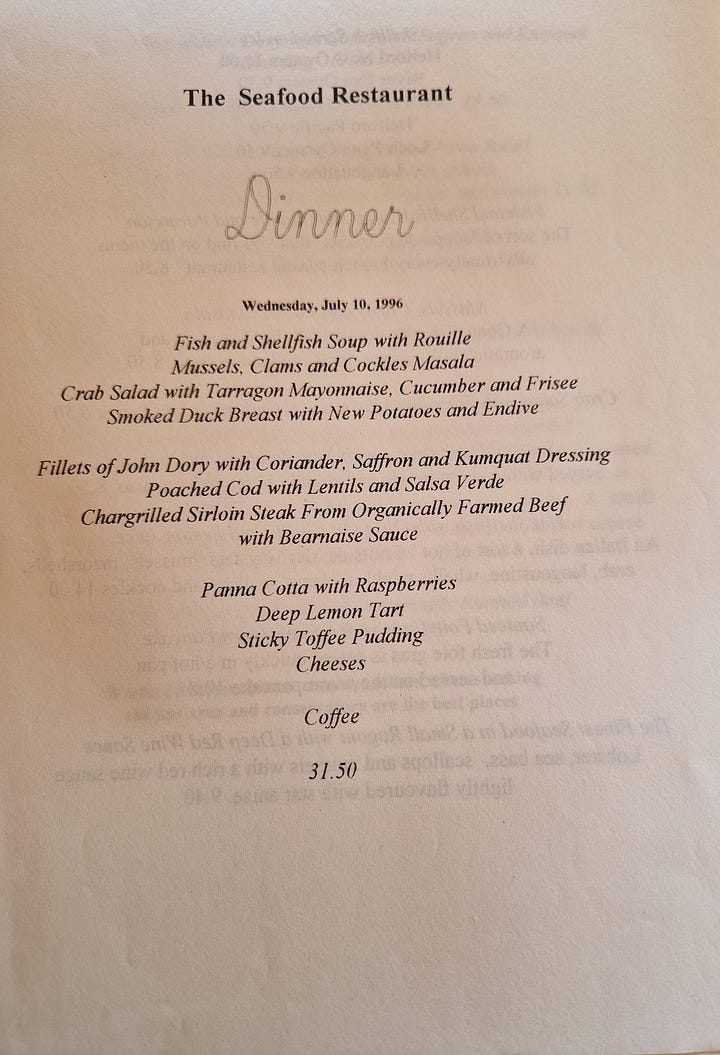
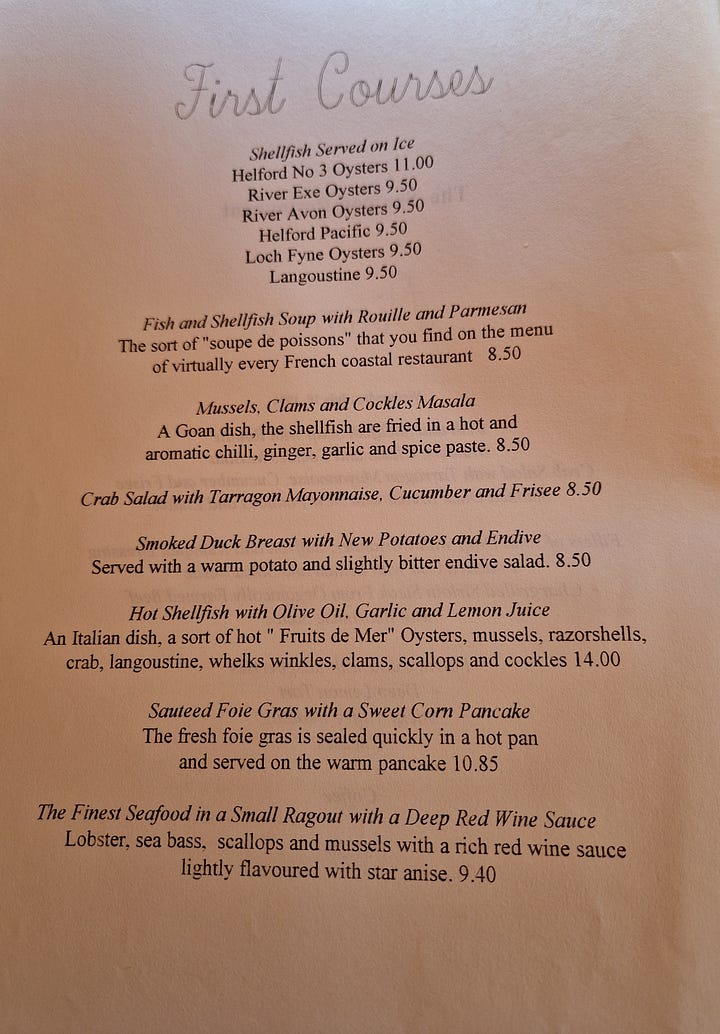
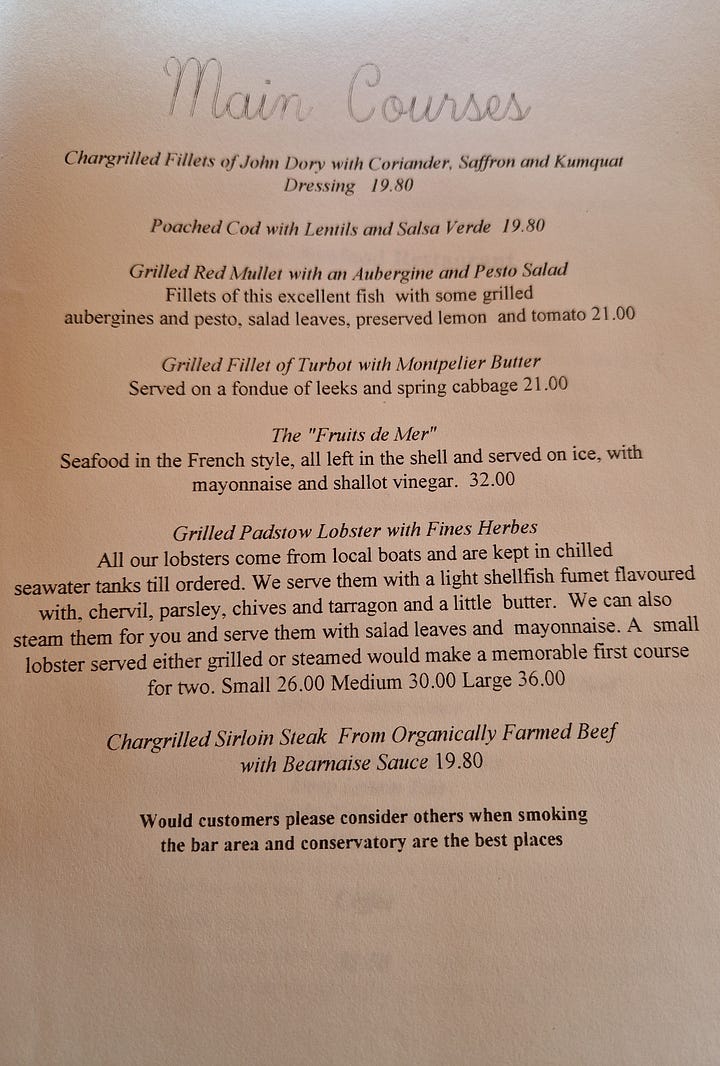
Everything that makes the dish pleasurable to eat - the firm, juicy white flesh, charred roasted skin, rich buttery sauce balanced by a tart whack of lemon juice - is brought into widescreen Panavision clarity by the dish’s unadorned simplicity. It’s probably more than a decade since I last ate the dish at Stein’s The Seafood Restaurant in Padstow, but it’s an indelible food memory. The dish is now part of a summer pop up menu, devised by Rick and his son Jack celebrating 50 years of The Seafood restaurant at Fortnum’s at The Royal Exchange. They will also be serving another Stein signature dish I recall fondly from my first visit to Padstow in 1996, the hot shellfish starter, although, sadly, it no longer costs £14.
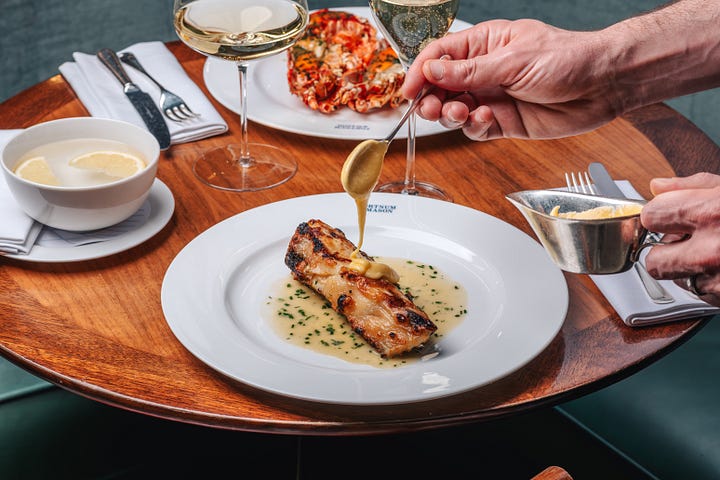
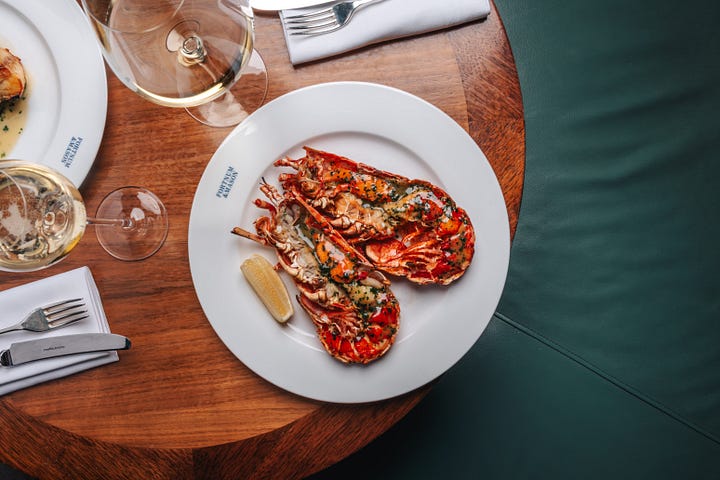
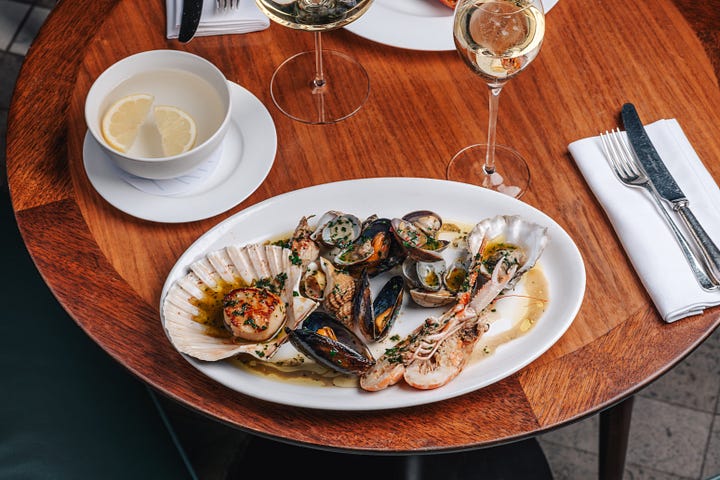

Although Stein has a restaurant in Barnes, I think I’m correct in saying that this will be the first time his food has been available in central London, so it’s something of an event. I was sadly not able to make the launch event this week so I’m eager to discover if the London version of the dishes can live up to my memories of the Cornish originals. The pop up runs from now until 5 August and features the following five dishes that each represent a decade in the history of The Seafood Restaurant:
• 1975 – 1985 | Fish and shellfish soup, with rouille and croutons - £13.95
• 1985 – 1995 | Hot shellfish with garlic and lemon juice - £47.50
• 1995 – 2005 | Grilled Lobster with Fine Herbs- £79.50
• 1995 – 2005 | Half grilled Lobster with Fine Herbs - £42.50
• 2005 – 2015 | Roast tronçon of turbot with hollandaise sauce - £42.75
• 2015 – 2025 | Chocolate Fondant - £10.25
A three course menu for £60 will also be availble. See the restaurant’s website for full details.
The Details
Rick Stein at Fortnum’s: A Summer of Seafood
The Fortnum’s Bar & Restaurant at The Royal Exchange, 4-7 The Royal Exchange, London, EC3V 3LR. 020 7734 8040; fortnumandmason.com
Something to cook: Recipes from the Roti King cookbook
AYAM GORENG BEREMPAH
Roti King Fried Chicken
This fried chicken can be served on its own or as part of a bigger meal with lots of other sides. It’s also traditionally served as part of Nasi lemak (see book for recipe). The marinade in this recipe makes enough for two batches of chicken. I recommend storing the extra in a sterilized jar in the fridge, where it will keep for up to a week, or freezing it. Once you’ve made this, you will want to eat it again before too long.
SERVES 6
PREP TIME 15 MINUTES, PLUS 1 HOUR–24 HOURS TO MARINATE
COOK TIME 10 MINUTES
40g (1½oz) cornflour (cornstarch)
30g (1oz) rice flour
200ml (7fl oz) vegetable oil, plus more for deep-frying
1.2kg (2lb 7oz) small chicken, skin on, chopped into 14 or equiavalent cuts of your choice (see note)
10 curry leaves
For the lemak marinade
1 large onion, roughly chopped
3 lemongrass sticks, tops cut off and bottoms bashed and roughly chopped
1 tsp Garlic paste
2 tsp Ginger paste
10 lime leaves, stalks removed
10g (¼oz) turmeric large handful of curry leaves
80ml (2½fl oz) vegetable oil
1 tsp curry powder
2 tsp salt
Add all the marinade ingredients to a blender and blitz to a smooth paste.
Mix half of the marinade with the cornflour, rice flour and vegetable oil. Place the chicken pieces in a large mixing bowl and use your hands to work the marinade all over the chicken. Leave to marinate in a sealed container for a minimum of 1 hour and up to 24 hours in the fridge, before frying.
When you’re ready to cook, pour enough vegetable oil into a medium saucepan so that it reaches halfway up. Place it over a medium heat and once the oil reaches 165°C (330°F) fry the chicken in batches for 6–10 minutes, turning carefully with tongs, until golden and crispy. Remove with a slotted spoon and drain on paper towels. Add the curry leaves to the pan for 30 seconds or until crispy, then remove with a slotted spoon and drain on paper towels.
Serve the chicken hot with the crispy curry leaves.
NOTE
If you prefer to avoid having to cut up the chicken, you can buy cuts of your choice, such as legs or thighs. Just be sure to buy skin-on and bone-in, as these add so much flavour. Ensure the pieces of chicken are similar sized as cooking times may vary
MAMAK MEE GORENG
Fried noodles with tofu and prawns
‘Mamak’ refers to the Indian origins of this dish, while mee means ‘noodles’ and goreng is ‘fried’. This is a dish I tried to learn to cook for a while. Back home in Ipoh there was one particular spot that sold a very good version of this, so to learn the flavours in hope of recreating this myself, I ate this a lot – at one point a few times a week! I’ve tweaked it over the years, but I owe this recipe to the man whose version was so good I kept returning to it. And to myself for such commitment to eating my favourite meal until I could make it myself – the best kind of research! The Roti King mee goreng includes chicken and prawns, but here I use just prawns and tofu, which is my favourite variation.
SERVES 2
PREP TIME 10 MINUTES
COOK TIME 5 MINUTES
2 tbsp vegetable oil
6 medium prawns (shrimp), peeled
1 garlic clove, finely chopped
2 eggs
270g (9½oz) cooked egg noodles
2 fried tofu puffs, sliced
large handful of beansprouts
For the sauce
2 tsp dark caramel sauce
2 tsp light soy sauce
2 tbsp oyster sauce
2 tbsp Basic sambal (see book for recipe or use shop bought)
½ tsp shrimp paste
1 tsp chicken powder
1 tsp caster (superfine) sugar
3 tbsp roasted peanuts, bashed using a pestle and mortar or finely chopped
Before you get started, it’s important to note that a hot pan is essential here – the food must be cooked over a high heat in order to achieve the best results. It comes together very quickly, so you need to have all the ingredients prepped before you heat the pan, and add them in the exact order in which they appear in the recipe. Have a wooden spoon or spatula ready to move the ingredients around the pan as soon as they’re added.
In a medium bowl, combine all the ingredients for the sauce.
Heat a large non-stick frying pan over a high heat. Pour in the oil, once hot add the prawns, moving them around the pan quickly, then after 30 seconds–1 minute, once they’re pink, move them to the side of the pan and add the garlic. Stir for 10 seconds before moving the garlic to the side of the pan with the prawns as you crack the eggs into the pan. Leave for 10 seconds (as if you are frying the eggs) before stirring them together, breaking them up and mixing with the prawns and garlic. Continue to stir and scrape the bottom of the pan as you go so that it doesn’t stick or burn (don’t be tempted to turn the heat down). Add the cooked egg noodles, keeping |the heat high. Next add the tofu and then immediately pour over the sauce. Mix until everything is well coated and scatter over the beansprouts, stir for a minute before serving.
SATAY
Chicken or lamb and peanut sauce
Inherited from Indonesian cuisine, satay refers to any meat marinated and cooked on sticks – think of it as Southeast Asia’s version of the kebab, commonly a dish cooked over charcoal at roadside stalls. This recipe makes more marinade than needed for either the chicken or the lamb, but the extra keeps well in a jar in the fridge for up to 3 weeks or frozen in portions for up to 6 months. For best results, marinate the meat overnight. You’ll need bamboo skewers for this recipe – soak these overnight. The sauce is served alongside for dipping.
MAKES 10 SKEWERS
PREP TIME 10 MINUTES PLUS 4 HOURS MARINATING
COOK TIME 30 MINUTES
350g (12oz) chicken thighs, boneless, skin on, chopped into chunky strips
OR
400g (14oz) small lamb cutlets
100g (3½oz) marinade (see below)
For the marinade
4 lemongrass sticks, tops cut off and bottoms bashed and roughly chopped
30g (1oz) galangal, peeled
30g (1oz) turmeric
3 tsp salt
1 tsp Kashmiri chilli powder
4 tbsp dark brown sugar
5 tbsp vegetable oil
10g (¼oz) ginger
1 tsp ground coriander
1 tsp ground cumin
Add the marinade ingredients to a blender and blitz to a paste. Place the meat in a large dish or ziplock bag and pour over the marinade, ensuring the meat is completely covered. Transfer to the fridge and leave to marinate for 4 hours or overnight.
Combine all the glaze ingredients in a small bowl and set aside.
To make the satay sauce, start by making the paste by blending the galangal, ginger, coriander, cumin, dried chillies and shallots with 50ml (1½fl oz) of water, and mix together. Heat the oil in a medium pan over a high heat and add the paste along with the salt, then cook for 8–10 minutes, stirring continuously. Add the peanuts and 250ml (8½fl oz) of hot water to the pan, and stir to combine. Add the brown sugar, coconut milk, pandan leaf and tamarind and cook for a further 10 minutes over a medium heat.
When you are ready to cook the meat you’ll need a hot charcoal grill. Brush the meat with the glaze before cooking. Cook the chicken skewers for 4–5 minutes on each side or until cooked through and the lamb skewers for 2–4 minutes on each side or until cooked through.
Serve the chicken or lamb with the satay, either drizzled over or on the side


Recipes extracted from:
Roti King: Classic and Modern Malaysian Street Food by Sugen Sopal
£18.99, Quadrille Publishing Ltd
Use the following affiliate link to buy this book and support Smashed: buy now
Something to drink: Smoky Pasilla Chili Paloma from Fonda, London
Fonda is Mexico City-born chef Santiago Lastra’s second London restaurant, a more casual sister to the Michelin-starred KOL. Lastra cooks Mexican food but with British ingredients, so, for example, a Baja taco is made with Cornish cod. Similarly, the agave-driven cocktail list uses some British ingredients to evoke Mexican flavours (although the recipe below is an exception).
The Fonda mixology team say: ‘We focus on Palomas because we believe they’re a staple of traditional Mexican drinking culture - you find them everywhere, from local fondas (a family-owned eatery) to house and restaurants. Depending on the area, they are always adapted slightly, but the recipe will always more or less be based on the same things. We aim to celebrate and present them in a contemporary form, putting seasonal, local ingredients front and centre. We might use things like British rhubarb or gooseberries as the key players in our Micheladas (depending on what is available seasonally), sometimes lacto-fermenting ingredients to break down the natural sugars and form lactic acid. This metabolic process is what gives the Palomas a sour, citrusy flavour without relying on lime juice and grapefruits themselves.
Smoky Pasilla Chili Paloma
(serves 1)
30g Fonda Espadin Mezcal
3.5 Pasilla Mezcal
10g Ancho Reyes
7.5g Verjus
2g Agave Syrup
0.2g Saline Solution
100g Three Cents Grapefruit Soda
Mix all the ingredients and serve in a highball with ice.
The details
Fonda, 12 Heddon Street, London, W1B4BZ. 020 3994 8888; fondalondon.com.
Something to Read: Notes on a Napkin
If you're curious about what happens behind the scenes at a restaurant, you will love Notes on a Napkin. Bristol-based restaurateur Dan O’Regan describes his recently launched newsletter as ‘a behind-the-scenes look at what really goes on — the myths, the madness, the moments that matter — written by a self-taught restaurateur still figuring it all out.’ O’Regan runs the critically acclaimed Bank and Lapin and is frank and funny about the hospitality industry.
So far, he’s covered subjects including ‘Where the Money Goes: Anatomy of a British Restaurant in 2025’ (‘Burrata costs more than beef. Storms wipe out seafood supplies or send prices soaring. Turbot is delicious, but not at £50 a portion’, why ‘Everyone Thinks They Can Run a Restaurant’ (‘100-hour weeks, ovens that catch fire mid-service, and answering 2am emails because someone insisted we sprint to Tesco, buy sausages, and cook it for their hungry dog’) and ‘What Makes a Bad Review Good’ (‘One snotty comment from a stranger and suddenly you're questioning your life choices, your kitchen setup, your music playlist, and whether your entire existence is a lie built on under-seasoned courgettes’). It’s very well written, thought-provoking stuff. You could think of it as a more well-mannered Substack equivalent of Gary Usher’s old Twitter feed. I can’t wait for the next edition. Make sure you don’t miss it by subscribing here.












Thank you Andy for the recommendations. Ordered the Malaysian book, going to check out Lastra, following Dan and it isn’t 8am.